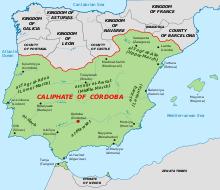
Back Al-Andalus ACE Al-Andalus ALS Al-Andalus AN الأندلس Arabic أندلوس ARY الاندلس ARZ Al-Ándalus AST Əndəlüs tarixi Azerbaijani Әл-Әндәлүс Bashkir Аль-Андалус Byelorussian

Al-Andalus[a] (Arabic: الأَنْدَلُس) was the Muslim-ruled area of the Iberian Peninsula. The term is used by modern historians for the former Muslim states in modern Spain and Portugal.[1] At its greatest geographical extent, it occupied most of the peninsula[2][3][4] and a part of present-day southern France, Septimania (8th century). For nearly 100 years, from the 9th century to the 10th, al-Andalus extended its presence from Fraxinetum into the Alps with a series of organized raids.[5][6][7] The name describes the different Muslim[8][9] states that controlled these territories at various times between 711 and 1492. These boundaries changed constantly as the Christian Reconquista progressed,[8][9][10] eventually shrinking to the south and finally to the Emirate of Granada.
Following the Muslim conquest of Spain, al-Andalus, then at its greatest extent, was divided into five administrative units, corresponding roughly to modern Andalusia; Castile and León; Navarre, Aragon, Catalonia; Portugal and Galicia; and the Languedoc-Roussillon area of Occitania.[11]
As a political domain, it successively constituted a province of the Umayyad Caliphate, initiated by the Caliph al-Walid I (711–750); the Emirate of Córdoba (c. 750–929); the Caliphate of Córdoba (929–1031); the taifa kingdoms that succeeded the Caliphate of Córdoba (1009–1110); the Almoravid Empire (1085–1145); the second taifa period (1140–1203); the Almohad Caliphate (1147–1238); the third taifa period (1232–1287); and ultimately the Nasrid Emirate of Granada (1238–1492).
This civilization was quite advanced at architecture and urban planning. The Moors were very wealthy because they controlled the gold trade from the Ghana Empire in West Africa. They built many beautiful buildings in all the land they controlled. Many of their large buildings still stand in cities in Andalusia, such as in Seville, Granada, and Cordoba.
Muslim Spain was multicultural and comparatively tolerant; Jews, Christians and Muslims lived side by side. There was also a saqaliba population (the descendants of European slaves) near the Mediterranean coast. Though these people were at first brought in to be slaves, some of them became generals (as did some Mamluks in another caliphate) and some generals became rulers of their own cities (taifas) for a short time.
In 1236, the Reconquista (gradual Christian reconquest) under the forces of Ferdinand III of Castile progressed as far as the last remaining Islamic stronghold, Granada. Granada was reduced to a vassal state to Castile for the next 256 years, until January 2, 1492, when Boabdil surrendered complete control of Granada to Ferdinand and Isabella.
Cite error: There are <ref group=lower-alpha> tags or {{efn}} templates on this page, but the references will not show without a {{reflist|group=lower-alpha}} template or {{notelist}} template (see the help page).
- ↑ Gómez-Rivas, Camilo (21 November 2014). Law and the Islamization of Morocco under the Almoravids: The Fatwās of Ibn Rushd al-Jadd to the Far Maghrib. Brill. pp. 1, note 3. ISBN 978-90-04-27984-1.
- ↑ Irvin, Dale T.; Sunquist, Scott (2002). History of the World Christian Movement: Volume 1: Earliest Christianity To 1453. A&C Black. p. 30. ISBN 978-0-567-08866-6.
- ↑ Luis Corral, Fernando (2009). "The Christian Frontier against al-Andalus (Muslim Spain): concept and politics during the reigns of King Fernando I of Castile and Leon and his successors until 1230". In Natalie Fryde; Dirk Reitz (eds.). Walls, Ramparts, and Lines of Demarcation: Selected Studies from Antiquity to Modern Times. LIT Verlag Münster. p. 67. ISBN 978-3-8258-9478-8.
- ↑ García Fitz, Francisco (2010). Rogers, Clifford J.; Caferro, William; Reid, Shelley (eds.). The Oxford Encyclopedia of Medieval Warfare and Military Technology. Oxford University Press. pp. 325–326. ISBN 978-0-19-533403-6.
Barely eight years after the initial crossing of the Straits of Gibraltar, the Muslims had come to dominate almost the entire Peninsula with the exception of a few northern mountainous regions along Cantabrian and Pyrenean ranges. In these areas, indigenous populations, including the Asturians, Cantabrians, and Basques, who had been brought under Visigothic control, were able to escape Islamic domination.
- ↑ Versteegh, Kees (1990-01-01). "The Arab Presence in France and Switzerland in the 10th Century". Arabica. 37 (3): 359–388. doi:10.1163/157005890X00041. ISSN 1570-0585. JSTOR 4057147.
- ↑ Wenner, Manfred W. (August 1980). "The Arab/Muslim Presence in Medieval Central Europe". International Journal of Middle East Studies. 12 (1): 59–79. doi:10.1017/S0020743800027136. ISSN 1471-6380. JSTOR 163627. S2CID 162537404.
- ↑ Some authors mention bands penetrating as far north as Sankt Gallen, where they sacked the monastery in 939. Cf. Ekkehard, Casus S. Galli, IV, 15 (pp. 137f); Lévi-Provençal (1950:60); Reinaud (1964:149f).
- ↑ 8.0 8.1 "Para los autores árabes medievales, el término Al-Andalus designa la totalidad de las zonas conquistadas – siquiera temporalmente – por tropas arabo-musulmanas en territorios actualmente pertenecientes a Portugal, España y Francia" ("For medieval Arab authors, Al-Andalus designated all the conquered areas – even temporarily – by Arab-Muslim troops in territories now belonging to Spain, Portugal and France"), García de Cortázar, José Ángel. V Semana de Estudios Medievales: Nájera, 1 al 5 de agosto de 1994, Gobierno de La Rioja, Instituto de Estudios Riojanos, 1995, p. 52.
- ↑ 9.0 9.1 Benito Ruano, Eloy [in Spanish] (2002). Tópicos y realidades de la Edad Media. Real Academia de la Historia. p. 79. ISBN 978-84-95983-06-0.
Los arabes y musulmanes de la Edad Media aplicaron el nombre de Al-Andalus a todas aquellas tierras que habian formado parte del reino visigodo: la Peninsula Ibérica y la Septimania ultrapirenaica. ("The Arabs and Muslims from the Middle Ages used the name of al-Andalus for all those lands that were formerly part of the Visigothic kingdom: the Iberian Peninsula and Septimania")
- ↑ The Oxford Dictionary of Islam. Esposito, John L. New York: Oxford University Press. 2003. doi:10.1093/acref/9780195125580.001.0001. ISBN 0195125584. OCLC 50280143.
{{cite book}}: CS1 maint: others (link) - ↑ O'Callaghan, Joseph F. (1983-10-31). A History of Medieval Spain. Ithaca: Cornell University Press. p. 142. ISBN 0801468728. OCLC 907117391.